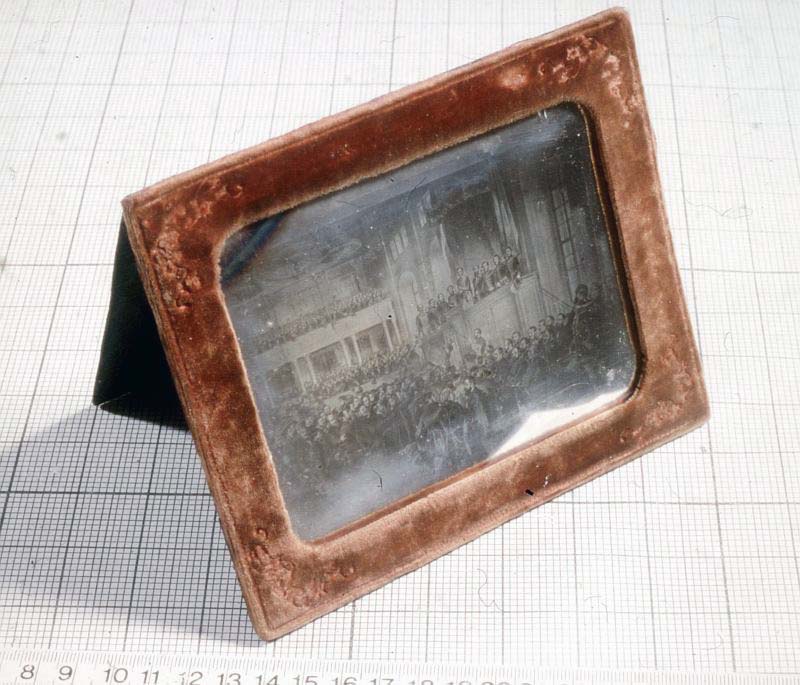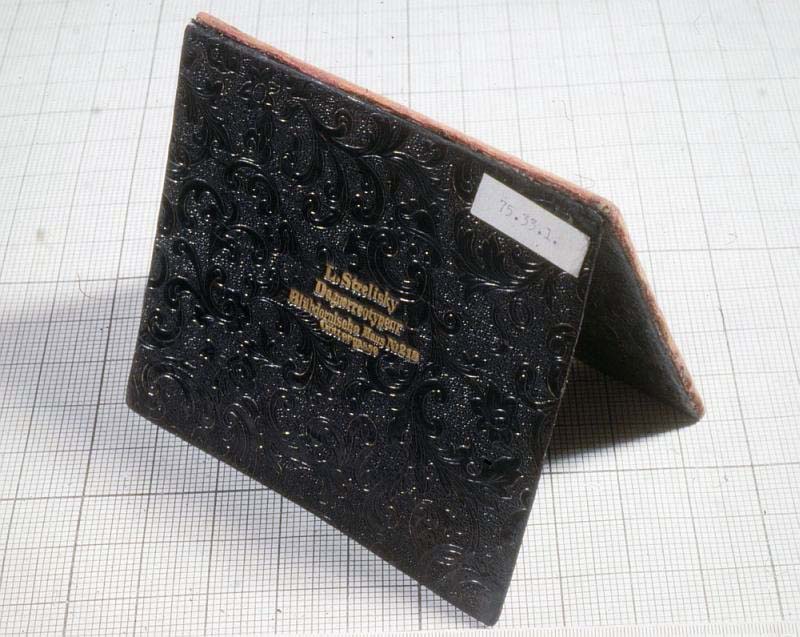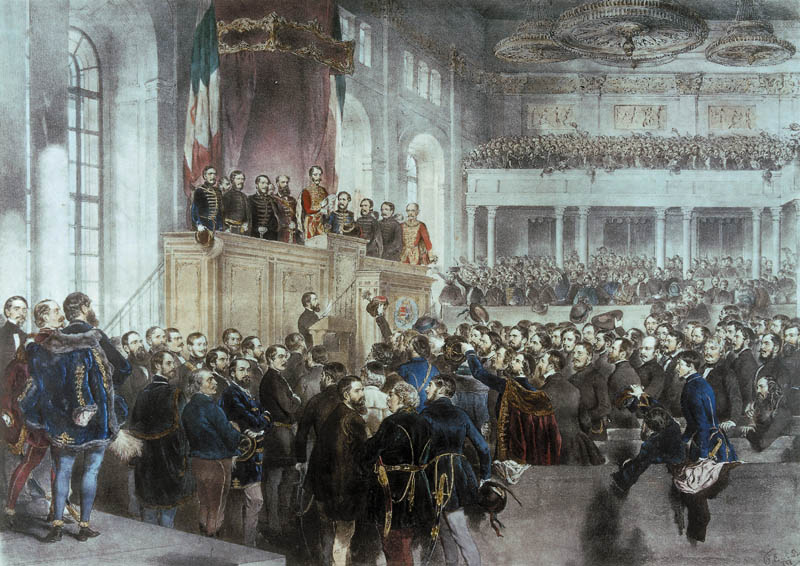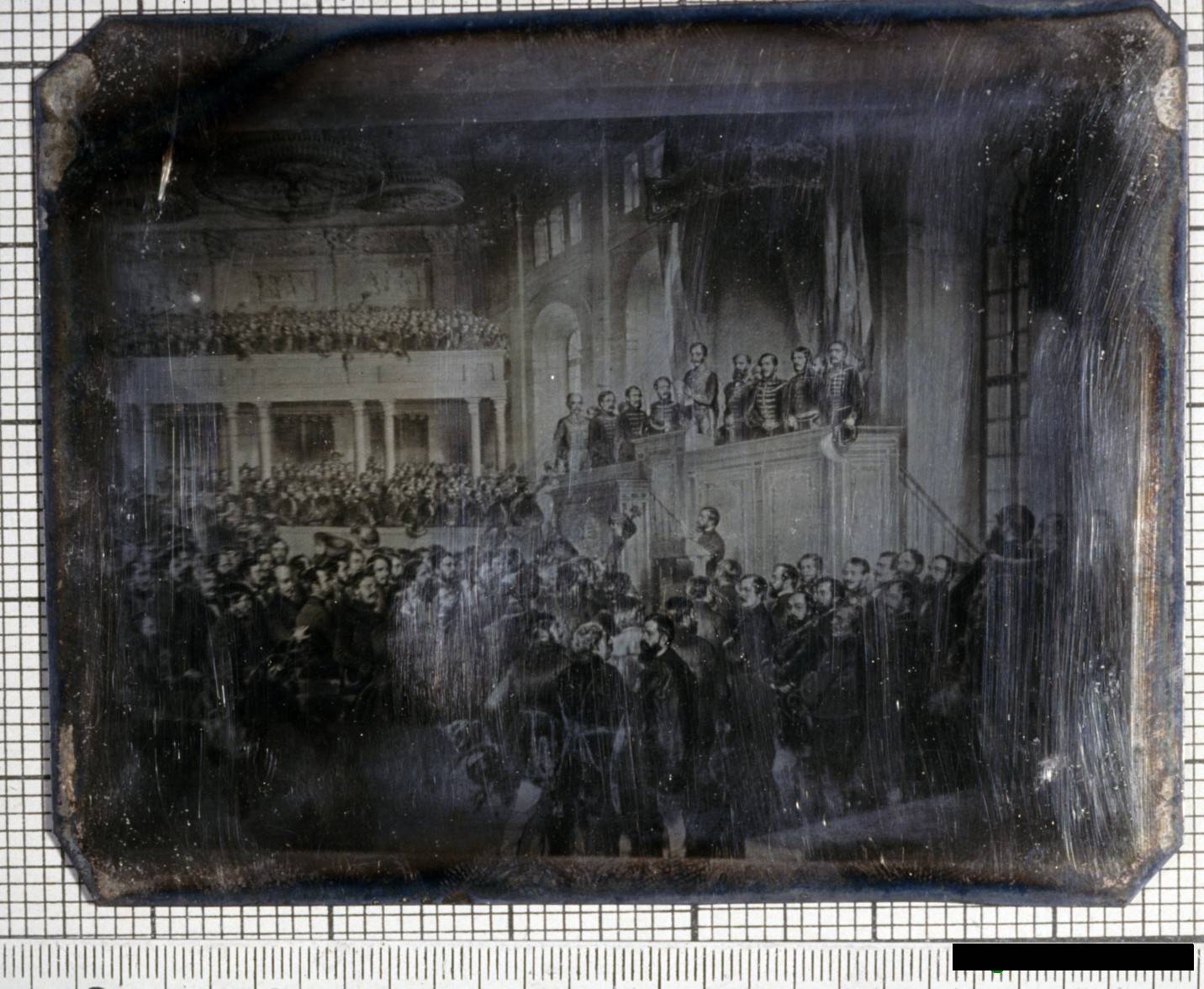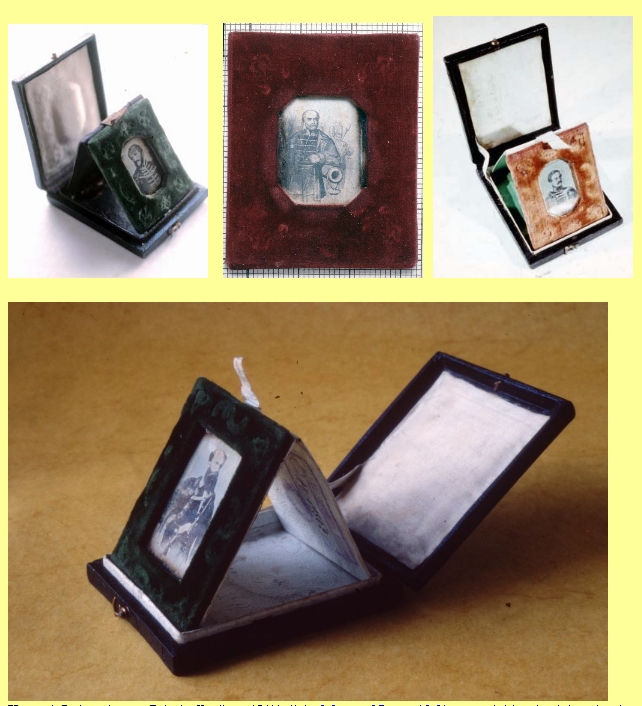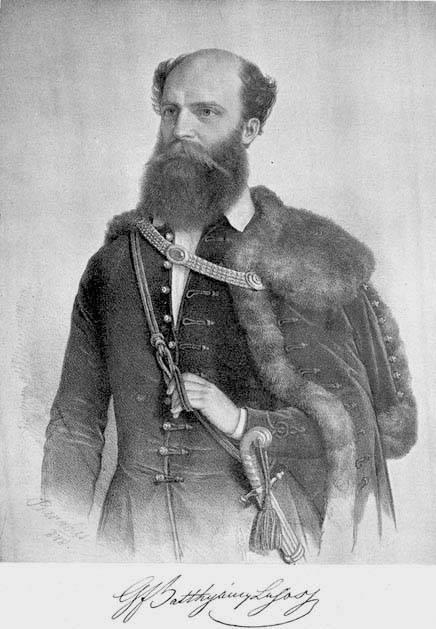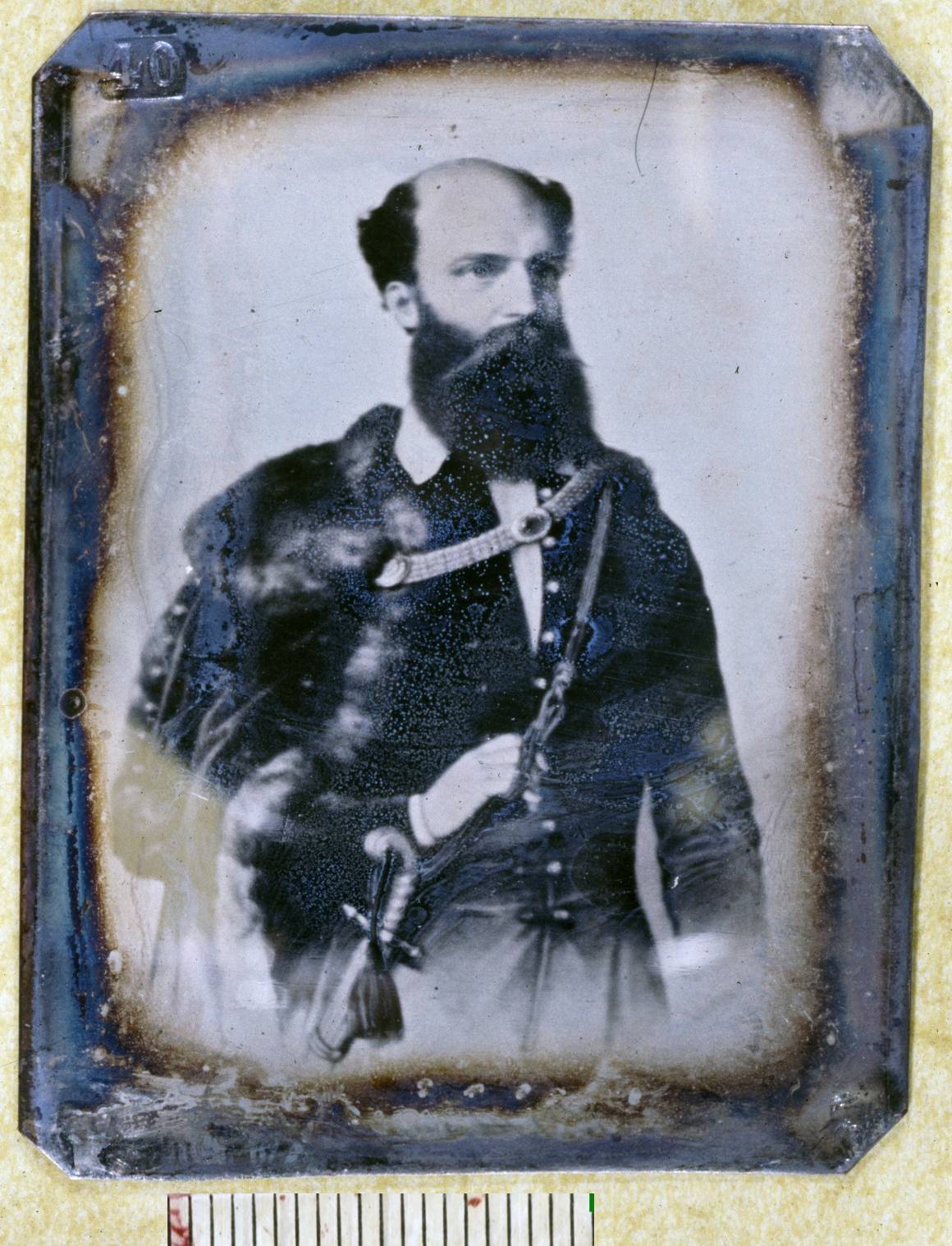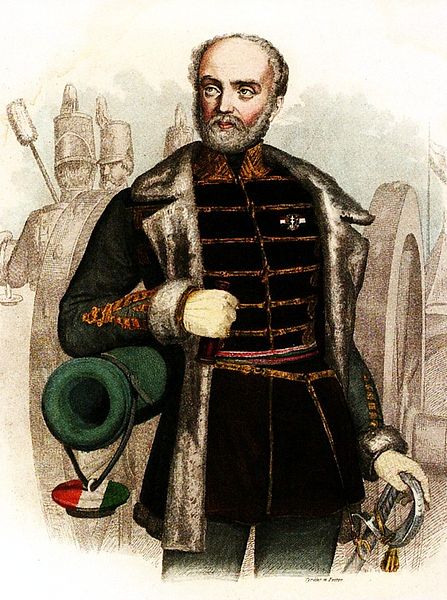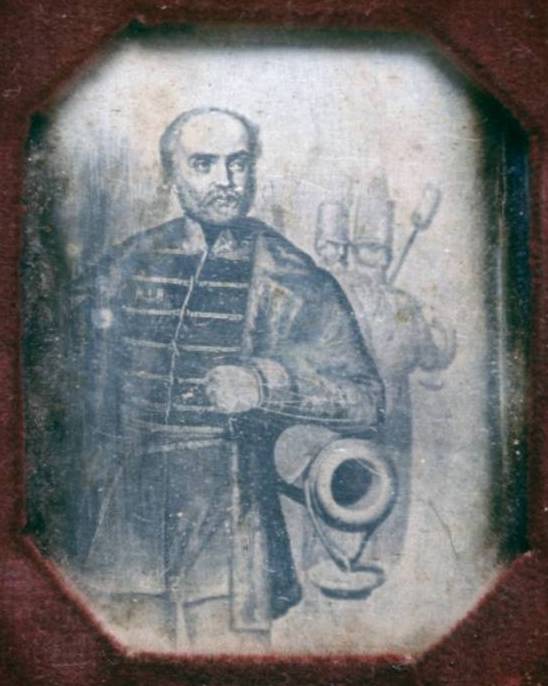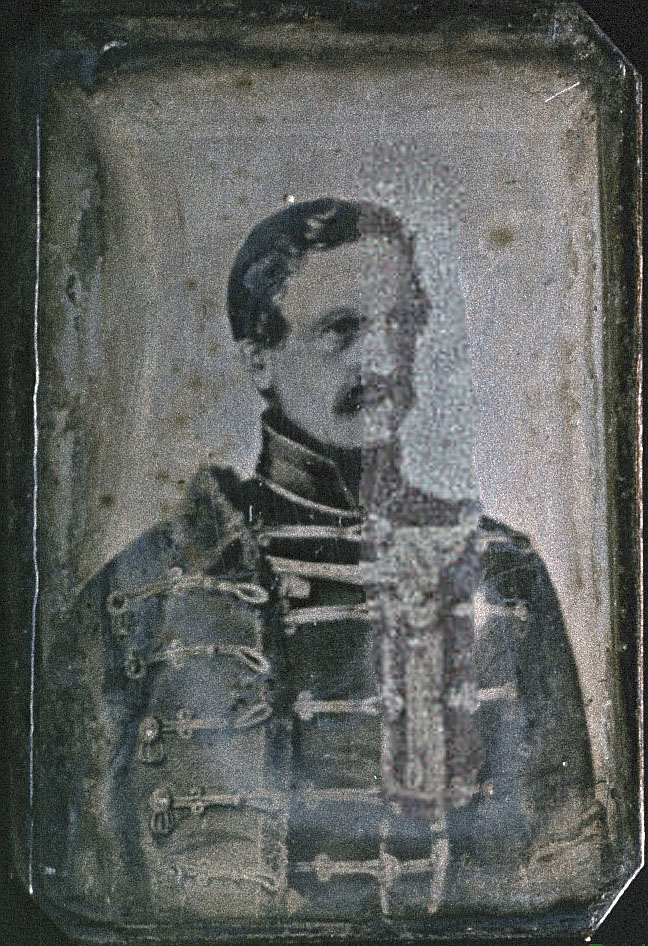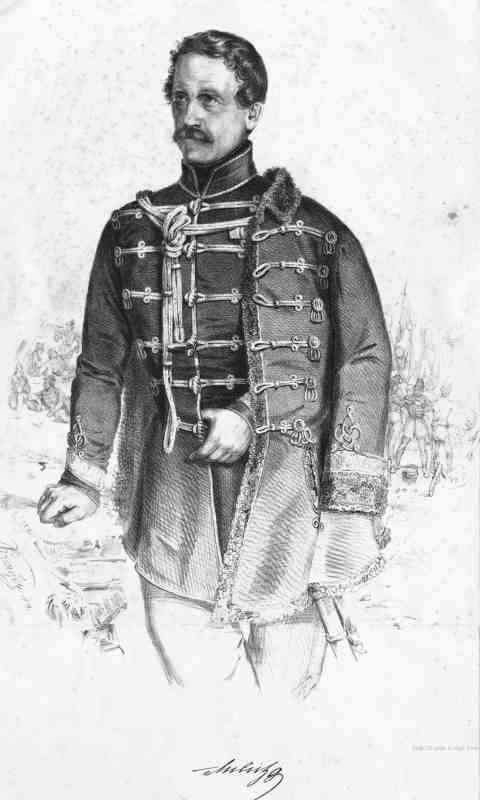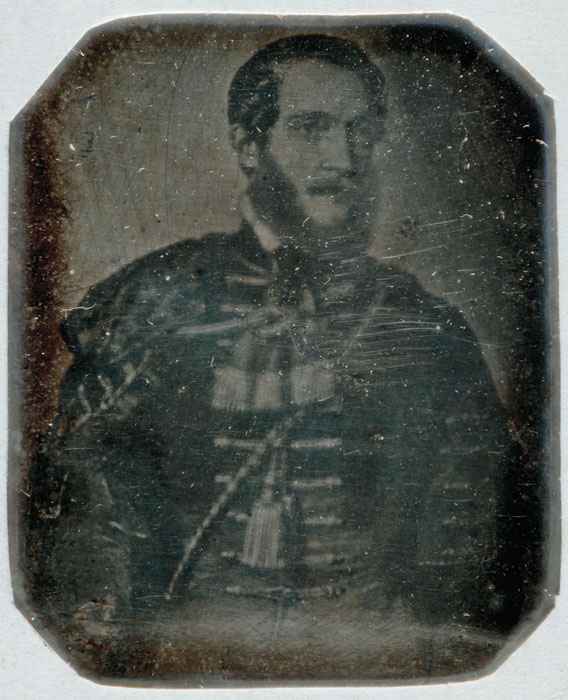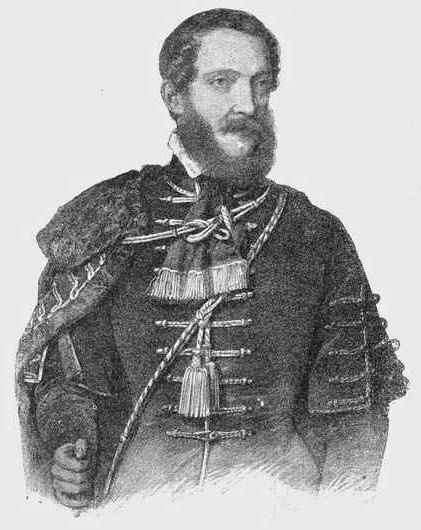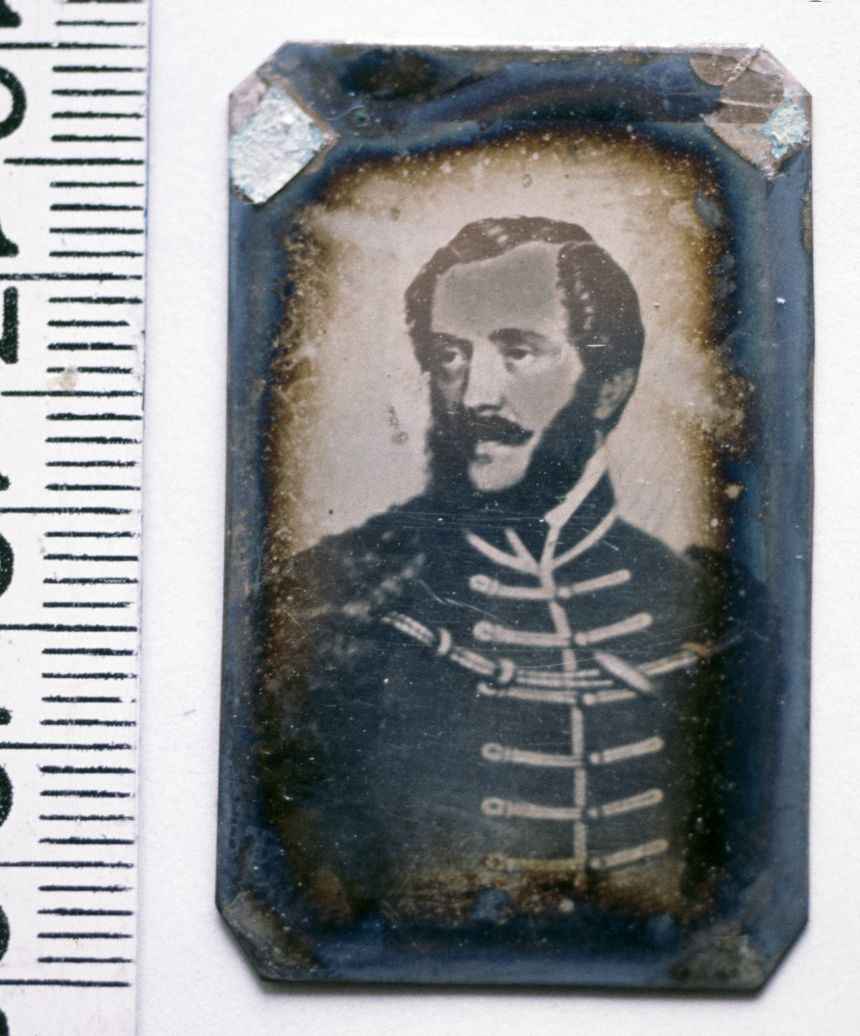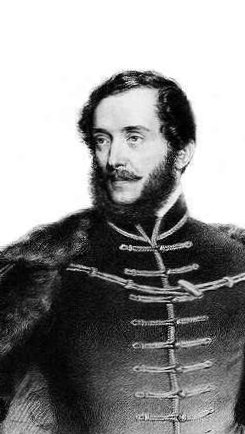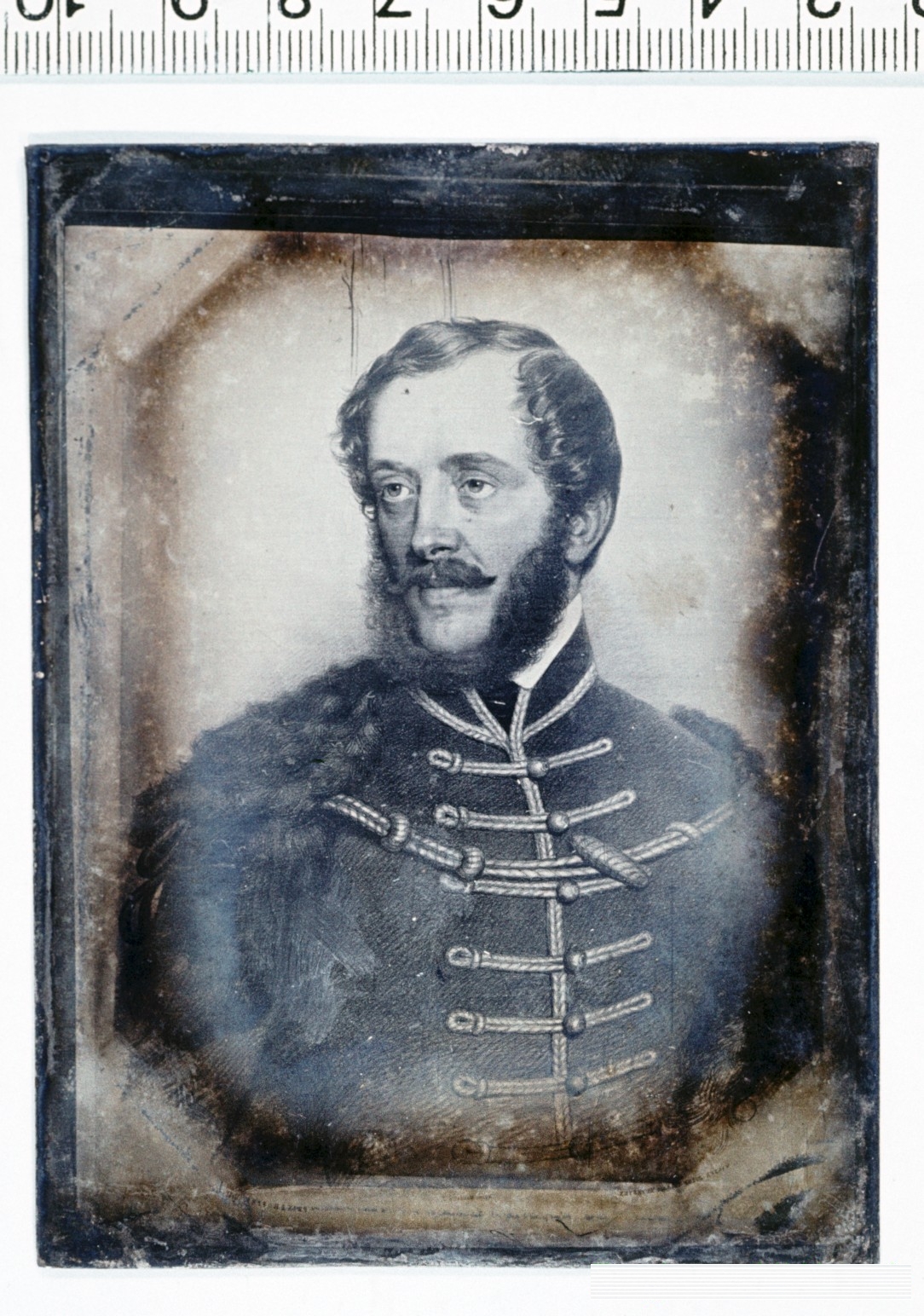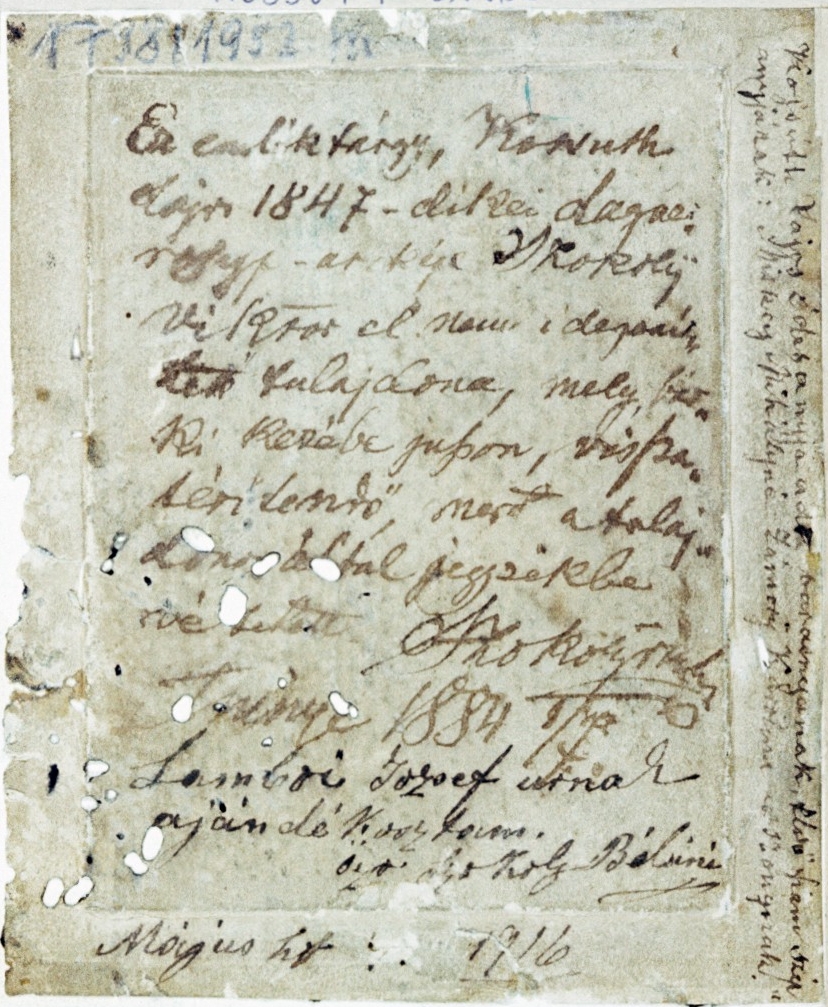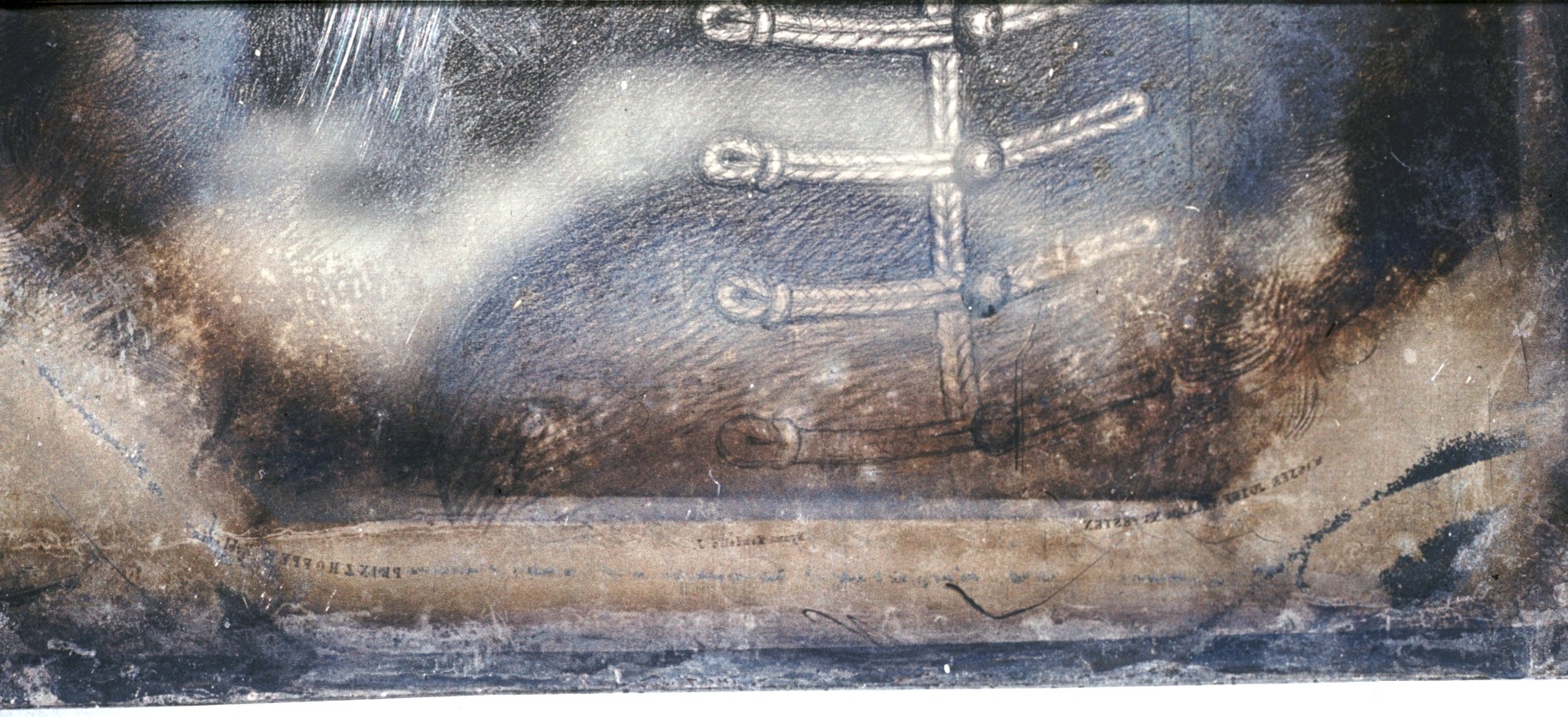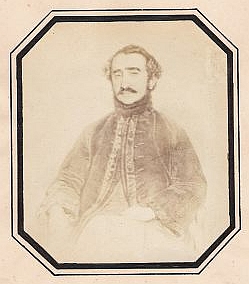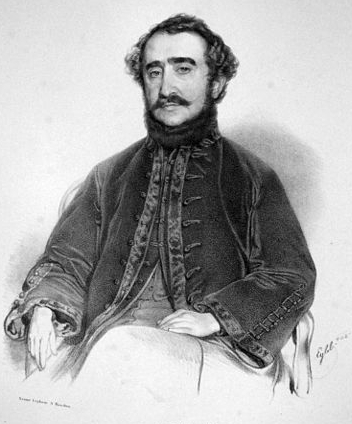Utolsó módosítás/ last update: 2015 .04. 01.
The tyranny and the history of photography.
After defeat of the 1848/49 Hungarian Revolution and War of
Independence, possessing a portrait of a participant of the war of
independence was for almost twenty years an indictable offence. This
period of our history created a new product.: miniature (easy-to-hide)
Daguerreotype reproductions were made of the graphic (engraving,
litography) portrays of the embelematic men of the resistance movement.
Lipót Strelisky was a significant member of the early Hungarian
photography. From goldsmith he became a photographer. I have not
found hallmarks on those plates known by me that were supposed to be
made by him. It can be supposed that as goldsmith, he (also) used
plates prepared by himself.
According to various sources he
served in the home guards during the Hungarian revolution (1848/49) and
photographed its prominent personalities partly with daguerreotype
partly with talbotype technique. The location of these pictures, if
still exist, is unknown. During the years of absolutism he continued to
distribute the pictures of the revolution’s main players reproduced
using photo technical processes (daguerreotype?) for which he was
imprisoned in the Újépulet (New Building, notorious prison), although in
the book by Etelka Baji about Strelinsky the contemporary judicial
books do not mention this fact. More than likely these pictures were
reproductions of artistic pictures prepared using graphical multiplying
processes (such as the one shown here).
Later, during the
collodion period the French René P. P. Dagron, one of the inventors of
the microfilm, made and inserted microscopic pictures about the
participants of the revolution, into all sorts of objects (stanhopes).
These were smuggled into Hungary.
Links
An
experiment to determine the author of the Petőfi daguerreotype using
computer evaluation of the data on the daguerreotype plates
http://archfot.t15.org/petdagen.html
Short History of the Daguerreotype Conservation in Hungary
http://archfot.t15.org/dagtoren.html
Note:the picture captions also in English... |
Strelisky Lipót a korai magyar fotográfia jelentős alakja volt.
Aranyművesből vált fényképésszé. A neki tulajdonítható, általam ismert
lemezeken ötvösjelet nem találtam elképzelhető, hogy aranyműves
szakemberként a saját maga által készített lemezeket (is) használhatta.
A különféle források, legendák szerint szabadságharc alatt nemzetőr
volt és részben dagerrotip, részben talbotip technikával fényképezte
annak nevezetes személyiségeit. Ezek a képek ma ismeretlen helyen
tartózkodnak, ha még megvannak egyáltalán. Az önkényuralom éveiben a
szabadságharc szereplőinek fototechnikai eljárással (dagerrotípiával?)
sokszorosított képeit terjesztette ezért az Újépületben is raboskodott
(bár Baji Etelka, Streliskyről szóló könyve szerint erről nincs adat a
korabeli bírósági forrásokban). E képei valószínűleg
sokszorosítógrafikai eljárással készült képzőművészeti ábrázolások
reprodukciói voltak (mint pl. az itt bemutatott).




Strelisky
dagerrotip reprodukciója Borsos József -August Pettenkoffen: Az első
magyar országgyűlés megnyitása (1848. julius 5. Pest.) c.
litográfiájáról
Hátlapja a szignóval : L. Strelisky Daguerreotypeur Blühdornische Haus No 218 Göttergasse.
Az egri Dobó István Múzeum tulajdona
Daguerreotype
reproduction of Strelisky of the lithography of József Borsos – August
Pettenkoffen: The opening of the first Hungarian parliament (5 July,
1848, Pest).
On the back with the sign: L. Strelisky Daguerreotypeur Blühdornische Haus No 218 Göttergasse.
Owned by the Dobó István Múzeum of Eger
Az
1848/49-es szabadságharc leverése után majdnem húsz éven keresztül
büntetendő cselekmény lett a szabadságharc szereplőinek képét
birtokolni. Emiatt közvetlenül a bukás után (mikor a megtorlás a
legkeményebb volt), maguk a tulajdonosok semmisítették meg tömegesen
(meg a hatóságok is persze) ilyen képeiket, vagy rejtették el olyan
helyekre ami a megmaradásuk szempontjából nem volt túl jó és felejtették
ott évtizedekig. Kis kitérővel megemlítenénk, hogy voltak ennek a
kornak hozadékai is: például az ellenállás kultuszához igen kisméretű
(jól elrejthető) dagerrotip reprodukciók készültek a korszak
hírességeinek sokszorosítógrafikai ábrázolásairól
Hazai gyűjteményekben több, az előbb bemutatotthoz hasonló technikájú,
installációjú ám igen kisméretü dagerrotip
reprodukció található a szabadságharc nevezetes szereplőit ábrázoló,
ismert sokszorosítógrafikai alkotásokról. Természetesen, ahogy ez a
dagerrotipjeink többségénél lenni szokott -- s itt az ok is érthető --
szignálatlanul. Nagyon az az érzésem, hogy ezek is Streliskytől
származhatnak remélem majd bizonyítékot is találok (vagy valaki más). Ez
a most érintett téma szintén megérdemelne némi kutatást és e képek
újrafelfedezését a fotótörténet számára.
 Kossuth Lajos, August Prinzhoffer litográfiájáról ( a Magyar Nemzeti Múzeum tulajdona)
Kossuth Lajos, August Prinzhoffer litográfiájáról ( a Magyar Nemzeti Múzeum tulajdona)
Bem József, Tyroler József rézmetszetéről (a Magyar Fotográfiai Múzeum tulajdona)
Aulich Lajos, Krauser litográfiájáról (a Magyar Nemzeti Múzeum tulajdona)
Batthyány Lajos, Barabás Miklós litográfiájáról (a Magyar Nemzeti Múzeum tulajdona)
Lajos Kossuth, politician from the Prinzhoffer lithography ( owned by the Hungarian National Museum)
József Bem, general, from the Tyroler copper engraving (owned by the Hungarian Museum of Photography)
Lajos Aulich, executed minister of war, from the Krauser lithography (owned by the Hungarian National Museum)
Lajos Batthyány, executed prime minister, from the Barabás lithography (owned by the Hungarian National Museum)
Ezeken
a képeken látható az is milyen egy jellegzetes és komplett, az 1840-es
évek második felében mifelénk használt dagerrotip installáció.
Batthyány Lajos, Barabás Miklós litográfiájáról (a dagerrotip a Magyar Nemzeti Múzeum tulajdona)
Lajos
Batthyány, executed prime minister, from the Barabás lithography (the
daguerreotype is owned by the Hungarian National Museum)

 Bem József, Tyroler József rézmetszetéről (a dagerrotip a Magyar Fotográfiai Múzeum tulajdona)
József Bem, general, from the Tyroler copper engraving (the daguerreotype is owned by the Hungarian Museum of Photography)
Bem József, Tyroler József rézmetszetéről (a dagerrotip a Magyar Fotográfiai Múzeum tulajdona)
József Bem, general, from the Tyroler copper engraving (the daguerreotype is owned by the Hungarian Museum of Photography)


Aulich Lajos, Krauser litográfiájról (a dagerrotip a Magyar Nemzeti Múzeum tulajdona) és az eredeti litográfia egyik változata
Lajos Aulich, executed minister of war, from the Krauser lithography (daguerreotype owned by the Hungarian National Museum) And a version of the original litography.
Dagerrotip reprodukció Kossuth Lajos, Walzel A. kőnyomata Barabás Miklós 1847-iki rajza után. 3 x 2,5 cm
A dagerrotip a Magyar Nemzeti Múzeum tulajdona. Mellette az eredeti
grafika egy változata oldalfordítottan, ahogy a dagerrotip ábrázolja.
Lajos Kossuth, politician, reproduction from the Barabás Miklós lithography 1847, 3 x 2,5 cm
( the daguerreotype owned by the Hungarian National Museum) and the
original graphic, reversed position as seen on the daguerreotype
August Prinzhoffer Kossuth Lajost ábrázoló litográfiájáról készített dagerrotipreprodukció. 26 x 40 mm
A Magyar Nemzeti Múzeum tulajdona.
Mellette az eredeti grafika részlete oldalfordítottan, ahogy a dagerrotip ábrázolja.
Lajos Kossuth, politician, reproduction from the August Prinzhoffer lithography 26 x 40 mm ( owned by the Hungarian National Museum)
and a detail of the original graphic reversed position as seen on the daguerreotype
A teljes grafika / source of the whole litography ahttp://www.kepido.oszk.hu/attachments/images/nagy/szi074.jpg címen látható



Mégegy dagerrotip reprodukció.ugyanarról a grafikáról, a védőcsomagolás hátoldala és egy közeli részletkép
Another daguerreotype from the same graphic, the verso of thre preserver and a detail of the plate
A Magyar Nemzeti Múzeum tulajdona. Property of the Hungarian National Museum


És
egy talboptípia is: Skopall József az 1850-es években készült talbotip
reprodukciója Széchenyi István egy Franz Eybl által 1842-ben készített
litográfiáról A fotó a Xantus János Múzeum tulajdona,
István Széchenyi, a calotype of József Skopall from a litography of Franz Eybl. Property of the Xantus János Museum
Forrás/Source:-Farkas Zsuzsa: Skopáll József győri talbotípiái 1850-1852-ből http://www.mafot.hu/farkas_zsuzsa-skopall_jozsef.html
Később,
a kollódiumkorszakban mikroszkópikus méretűre kicsinyített képeket
készített és applikált különböző használati tárgyakba a szabadságharc
ismert személyiségeiről a francia René P. P. Dagron a mikrofilm
feltalálója, amelyeket aztán valahogy becsempésztek Magyarországra. (E
szerkezet neve stanhope és 1859-ben találta fel Dagron, a mikroméretű
kép egy nagyítóként működő kristályon keresztül volt szemlélhető) Egy
ilyen gyűrű van a Nemzeti Múzeum birtokában, a Hadtörténeti Múzeumban
meg egy pipa, a Móra Ferenc Múzeumban egy nyakkendőtű, stb.
Linkek:
Kísérlet a Petőfi dagerrotip szerzőjének megállapitására, dagerrotip lemezek adatainak számitógépes értékelése segitségével
http://archfoto.atspace.eu/petdagel.html
A magyarországi dagerrotip konzerválás rövid története
http://archfoto.atspace.eu/dagtor.html
Az emlegetett technikák elmagyarázása a Kislexikonban.
http://archfoto.atspace.eu/klexframe.html
Felhasználtam még az alábbi írást:
Csengel-Plank Ibolya: A képcsempészet sajátos formái 1849 után
A Hadtörténeti Múzeum értesítője, 0238-4442. 11. 2010. p. 23-43.
Régebbi bejegyzések a témában:
Petőfi dagerrotípia, meg a valósághoz való viszony. Mindenmaradarégiben.

